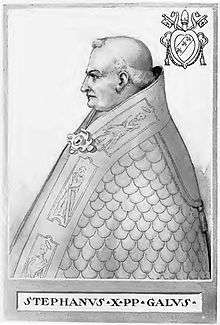Pope Stephen IX
| Pope Stephen IX | |
|---|---|
 | |
| Papacy began | 3 August 1057 |
| Papacy ended | 29 March 1058 |
| Predecessor | Victor II |
| Successor | Nicholas II |
| Personal details | |
| Birth name | Frédéric de Lorraine |
| Born |
c. 1020 Duchy of Lorraine, Holy Roman Empire |
| Died |
29 March 1058 Florence, Holy Roman Empire |
| Other popes named Stephen | |
Pope Stephen IX (Latin: Stephanus IX; c. 1020[1] – 29 March 1058) reigned from 3 August 1057 to his death in 1058.
Biography
Christened Frederick,[2] he was a younger brother of Godfrey III, Duke of Lower Lorraine,[3] and part of the Ardennes-Verdun dynasty that would play a prominent role in the politics of the period, which included their strong ties to the abbey of St. Vanne.[3]
Frederick would initially be archdeacon of a cathedral church in Liege called St. Lambert.[3] He was appointed Cardinal-Deacon of Santa Maria in Domnica by Pope Leo IX, and later raised to the Cardinal-Presbyter of San Crisogono by Pope Victor II.[4] In 1054, he discharged the function of one of three papal legates at Constantinople, participating in the events that led to the East-West Schism.[5] In 1057, he was appointed abbot of Monte Cassino.[6] Five days after the death of Pope Victor II, he was chosen to succeed him as Pope Stephen IX.[7]
He enforced the policies of the Gregorian Reform as to clerical celibacy. In regional politics, he was planning for the expulsion of the Normans from southern Italy, and in order to achieve that he decided, at the beginning of 1058, to send a delegation to the new Byzantine Emperor Isaac I Komnenos (1057-1059). Papal delegates departed from Rome, but when they reached Byzantine held Bari, news came that Stephen IX has died, and mission was abandoned.[6]
At the beginning of 1058, he was also planning the elevation of his brother to the imperial throne, when he was seized by a severe illness, from which he only partially and temporarily recovered. Stephen IX died at Florence on 29 March 1058 and is considered by the current-day Catholic Church to have been succeeded by Pope Nicholas II, though others consider his successor to be Pope Benedict X, officially regarded as an antipope.
See also
Notes
- ↑ Mittermaier, Karl (2006). Die deutschen Päpste. Benedikt XVI. und seine deutschen Vorgänger. p. 102.
- ↑ Kelly, Thomas Forrest, The Beneventan Chant, (Cambridge University Press, 1989), 39.
- 1 2 3 Patrick Healy, The Chronicle of Hugh of Flavigny: Reform and the Investiture Contest in the Late Eleventh Century, (Ashgate Publishing, 2006), 50.
- ↑ Charles Radding and Francis Newton, Theology, Rhetoric, and Politics in the Eucharistic controversy, 1078–1079, (Columbia University Press, 2003), 89.
- ↑ Siecienski 2010.
- 1 2 Bloch 1986, p. 38.
- ↑ He explicitly took the name and the number IX. He signed all his official documents Stephanus Nonus Papa (Stephen Ninth Pope), although some lists called him Stephen X from the second half of the 16th century to the first half of 20th.
References
- Adapted from the 9th edition (1888) of the Encyclopædia Britannica

Sources
- Bloch, Herbert (1986). Monte Cassino in the Middle Ages. 1. Roma: Edizioni di Storia e Letteratura.
- Siecienski, Anthony Edward (2010). The Filioque: History of a Doctrinal Controversy. Oxford University Press.

